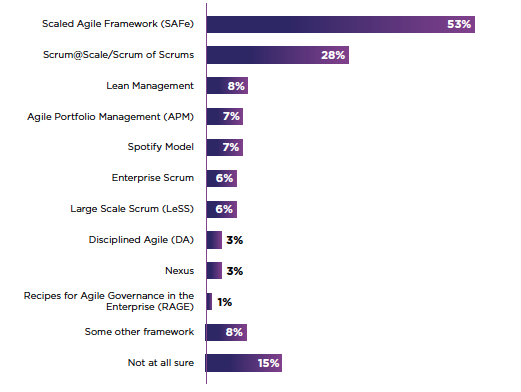You have decided to scale (REMINDER: Do not Scale if you don’t need to), and you have heard about Scrum@Scale, SAFe, and others. The choices can be confusing and complicated. It is time to determine what framework for scaling will work best for your Organization: Scrum@Scale or SAFe.
The 16th Annual State of Agile Survey lists the most popular Scaled Agile Frameworks

By implementing one of these frameworks, you will avoid reinventing the wheel. Each framework provides structure, process, and principles to follow. Let’s look at the characteristics of Scrum@Scale and SAFe.
Scrum@Scale
Scrum@Scale is the only scaled Scrum framework developed and endorsed by Dr. Jeff Sutherland, built on real-world experiences and proven empirical techniques used by teams and organizations around the globe to help teams accomplish “Twice the work in half the time.”
The Scrum@Scale Guide says: “Scrum@Scale helps an organization to focus multiple networks of Scrum Teams on prioritized goals. It aims to achieve this by setting up a structure that naturally extends how a single Scrum Team functions across a network and whose managerial function exists within a minimum viable bureaucracy (MVB). Scrum@Scale is a lightweight organizational framework in which a network of teams operates consistently with the Scrum Guide to address complex adaptive problems while creatively delivering products of the highest possible value. These “products may be physical, digital, complex integrated systems, processes, services, etc.”
The Scrum@Scale framework comprises two cycles: the Scrum Master Cycle, addressing the ‘how’ of the delivery process, and the Product Owner Cycle focusing on ‘what’ is being delivered.
The Scrum Master Cycle
The Scrum Master Cycle contains the following nodes:
- Executive Action Team
- Continuous Improvement
- Cross-Team Coordination
- Delivery
Product Owner Cycle
The Product Owner cycle works to accomplish the following nodes of the Product Owner Cycle:
- Executive Metascrum
- Strategic Vision
- Backlog Prioritization
- Backlog Decomposition & Refinement
- Release Planning.
The Scrum Master Cycle and Product Owner Cycle intersect at two key nodes and share a third:
- Team Level Process
- Product & Release Feedback
- Metrics & Transparency.
Here is a diagram of how the Scrum Master Cycle and the Product Owner Cycle work together.
Scrum@Scale Diagram

Scrum@Scale vs SAFe
Scrum@Scale recognized that organizations have four mega issues that need to be addressed to Scale successfully:
- Manage Priorities
- Delivery of Product(s)
- Building an effective Organization Culture
- Organization Refactoring
Scrum@Scale uses a unique heatmap approach to help develop a transformational roadmap. The Scaling Heatmap is a powerful tool to identify and prioritize the activities for the organization’s transformation. Depending on the scope of this transformation, the assessment can be performed at various levels: Org, division, or team.
Scaled Agile Framework (SAFe)
SAFe provides multiple levels for product delivery and provides guidance to scale across your entire enterprise. SAFe is often considered prescriptive and complex, and for a good reason, as it prescribes many roles, events, and practices. It can be difficult and require significant investment and commitment to implement and adopt into your current practices. There is not a lot of perceived flexibility within SAFe (this could be a whole blog post about how the perception is not necessarily accurate). The SAFe framework provides concrete guidance for each level of a complex organization.
There are three essential levels of SAFe: TEAM, PROGRAM, and PORTFOLIO.

SAFe vs. Scrum@Scale
TEAM LEVEL’s main aim is to provide value. Business Analysts, Developers, User Experience specialists, Testers, Product Owners, Scrum masters, and other key individuals are responsible and perform an essential role at the Team level. All Agile teams must focus on set values, events, and processes. Scrum, Kanban, or Extreme Programming can be utilized as the foundation for engineering techniques.
PROGRAM LEVEL is regarded as the most significant of all SAFe framework levels. The main focal point of the Program Level is The Agile Release Train (ART), which comprises 8 to 10 team members accountable for providing value to a project. The team will assess and plan how to dissolve features into simple fragments to expedite deliverables and feedback loops. The goal is to prioritize the most critical tasks at the top of the task lists. The Program Backlog is regularly reviewed and updated to prioritize tasks effectively.
THE PORTFOLIO LEVEL is where the objectives and goals for the entire organization are established. During this level, the emphasis is straightforward: the organization and its related priorities, purpose, and value. The portfolio of a mid-sized organization is comprised of the entire organization. In a larger company, there may be many portfolios. The portfolio team will take the following steps to aid in the creation of new products:
- Educating teams and program groups on Lean and Agile techniques
- Ensuring that the plans are carried out
- Assisting the teams in carrying out the projects
- Examining the value provided and calculating the portfolio’s efficiency
Scrum@Scale with One80
At One80, our preferred method is utilizing the Scrum@Scale framework. We know it is an incredibly adaptive tool to enhance the Agility of teams in a scaled environment. We offer a full suite of training classes on implementing the Scrum@Scale framework. We would love to help you implement this system into your company’s practices. Contact us to schedule a free training consultation.